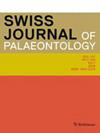Testing dental microwear as a proxy for characterising trophic ecology in fossil elasmobranchs (chondrichthyans)
IF 3
2区 地球科学
Q1 PALEONTOLOGY
引用次数: 0
Abstract
Dental microwear analysis is a well-established technique that provides valuable information about the diets of extant and extinct taxa. It has been used effectively in most major groups of vertebrates. However, in chondrichthyans, these methods have been implemented only recently in the form of dental microwear texture analysis, with conflicting results. Causes intrinsic to chondrichthyan biology, such as limited food-to-tooth contact, low diversity in terms of trophic categories or fast tooth replacement, have been suggested to reduce diet-related wear on individual teeth, hindering the use of this approach for reliable dietary reconstruction. Here, we explored the relationship between diet and dental microwear in chondrichthyans by using 2D analysis, which can provide finer-scale identification and accurate definition of scratch morphology from tooth surfaces a priori. Scratches were counted and measured on the teeth of 34 extant elasmobranchs grouped into three categories (piscivorous, durophagous and generalist) according to dietary preferences. Our results revealed specific patterns of tooth microwear as a function of dietary abrasiveness, enabling the discrimination of trophic groups and thus establishing a useful comparative framework for inferring aspects of trophic ecology in fossils. We then used this information to study dental microwear in six fossil species from the same locality and stratigraphic levels. First, analyses of the enameloid surfaces of the fossil show that post-mortem alterations are distinguishable, allowing reliable quantification of diet-related ante-mortem microwear signatures. Discriminant analysis allowed the recognition of microwear patterns comparable to those of living sharks and linked them to specific trophic groups with high probability levels (> 90%). Thus, microwear features developing on chondrichthyan teeth during feeding are intense enough to retain information regarding diet preferences. 2D microwear analysis can track this information, proving to be a useful tool for providing significant information not only about diet but also about oral processing mechanisms in extinct chondrichthyans.测试牙齿微磨损作为描述软骨鱼类化石营养生态特征的替代方法
牙齿显微磨损分析是一项成熟的技术,可提供有关现生和已灭绝类群饮食的宝贵信息。它已被有效地应用于大多数主要的脊椎动物类群。然而,在软骨鱼类中,这些方法直到最近才以牙齿微磨损纹理分析的形式得到应用,但结果却相互矛盾。有人认为,软骨鱼类生物学的内在原因,如食物与牙齿的接触有限、营养类别多样性低或牙齿替换快等,会减少单个牙齿上与食物相关的磨损,从而阻碍使用这种方法进行可靠的食物重建。在这里,我们利用二维分析探讨了软骨鱼类的饮食与牙齿微磨损之间的关系,二维分析可提供更精细的识别,并可事先准确定义牙齿表面的划痕形态。我们对 34 种现存软骨鱼类的牙齿上的划痕进行了计数和测量,并根据食物喜好将其分为三类(食鱼类、食黑鱼类和通食性鱼类)。我们的研究结果揭示了牙齿微磨损的特定模式与食物磨蚀性的函数关系,从而能够区分营养群,并因此建立了一个有用的比较框架,用于推断化石中营养生态学的各个方面。随后,我们利用这些信息研究了同一地点和地层中六个化石物种的牙齿微磨损情况。首先,对化石珐琅质表面的分析表明,死后的改变是可以区分的,从而可以对与饮食相关的死前微磨特征进行可靠的量化。通过判别分析,可以识别出与活鲨鱼相当的微磨损模式,并以很高的概率(大于 90%)将它们与特定的营养群联系起来。因此,软骨鱼类牙齿在进食过程中形成的微观磨损特征非常强烈,足以保留有关饮食偏好的信息。二维微观磨损分析可以追踪这些信息,被证明是一种有用的工具,不仅可以提供有关饮食的重要信息,还可以提供有关已灭绝的软骨鱼类口腔加工机制的重要信息。
本文章由计算机程序翻译,如有差异,请以英文原文为准。
求助全文
约1分钟内获得全文
求助全文
来源期刊

Swiss Journal of Palaeontology
Earth and Planetary Sciences-Paleontology
CiteScore
4.30
自引率
16.70%
发文量
17
审稿时长
4 weeks
期刊介绍:
The Swiss Journal of Palaeontology publishes original research and review articles of interest to the international community in the fields of palaeontology, taxonomy and systematics, while recognising at the same time the importance of documenting high-quality palaeontological data in a regional context. Palaeobiology in combination with alpha taxonomy is a core topic of the journal.
Submitted papers should have an appeal as wide as possible, directed towards an international readership. Contributions should not have been simultaneously submitted elsewhere, and the overlap of content between related articles should be minimal. Duplications of text and the use of previously published illustrations without adequate citation are unacceptable. If a manuscript has two or more authors, both or all have to sign to confirm they all were involved in the work and have agreed to its submission. The preferred manuscript language is UK English, but consistently used US English is also acceptable. We encourage the publication of proceedings of international meetings as well as special thematic issues. Short contributions and book reviews are also accepted.
An international editorial team as well as guest editors guarantee that the thematic issues as well as all articles in regular issues are peer-reviewed and meet the highest standards.
 求助内容:
求助内容: 应助结果提醒方式:
应助结果提醒方式:


